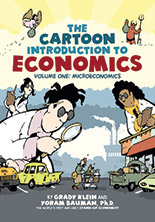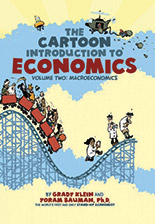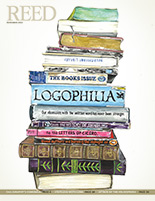
IRIS login | Reed College home Volume 91, No. 4: December 2012
Reediana
The Cartoon Introduction to Economics, Volumes I and II (Hill and Wang, 2010 & 2011)
Yoram Bauman ’95
Reviewed by Nisma Elias ’12


Ever since the historian Thomas Carlyle lumbered it with the tagline “the dismal science,” economics has had a reputation for the unpleasant, which is why creating cartoons about the subject seems like a crazy idea. Yet, this is what Yoram Bauman has done. Yoram, who has a PhD in economics from the University of Washington and performs around the world as a stand-up economist, has written a two-part textbook on economics that will make you chuckle as well as contemplate. The book is unique because it translates economic gibberish into plain English, along with zany illustrations to help the reader grasp basic economic concepts. As a former economics tutor, I know many intro econ students who would have loved to have a text like this to guide them as they explored a whole new way of thinking about the world.
The first part of the series, which is on microeconomics, tackles every economist’s favourite guinea pig, the optimizing individual (as we all try to maximize our preferences), or, as Yoram puts it, “the selfish jerk.” The text explores whether Adam Smith’s invisible hand leads to the good of the group as a whole, game theory strategies, and how the lack of money is the root of all evil. And in case you ever win the $20 million lottery, there’s an entire section on whether the smarter move is to take $10 million out right now or a $1 million annuity for the next 20 years.
What’s commendable is that Yoram does not hold market forces to be the solution to everything. He demonstrates how competitive forces in the market can cause huge turmoil—like monopoly prices, inequalities, and pollution. However, he also shows how each of these problems can be solved, by taxing polluters or forming antitrust policies, which can be implemented only after understanding the limitations of the free market.
The second part of the series covers macroeconomics, which builds on the foundations of microeconomics but attempts to answer completely different questions. Macroeconomics struggles with the two-headed beast of trying to maintain short-term stability while promoting long-term growth. The key differences of looking at the economy as an organized family (the classical view) versus a dysfunctional family (the Keynesian view) are explained to noneconomists to help them understand these two conflicting goals and issues such as the Great Depression. The phrase “too big to fail” is also explained, this time in the context of the Great Recession. This text manages to break down other important concepts, such as the working of the foreign currency market, why outsourcing is a good thing, and why economists are worried about not running out of fossil fuels. While accessible, the book is clever in the way it introduces a variety of economic fundamentals to the uninitiated.
If you’re still unsure about the difference between micro and macroeconomics, here’s a one-liner: “Microeconomists are wrong about specific things, and macroeconomists are wrong about things in general.”


LATEST COMMENTS
steve-jobs-1976 I knew Steve Jobs when he was on the second floor of Quincy. (Fall...
Utnapishtim - 2 weeks ago
Prof. Mason Drukman [political science 1964–70] This is gold, pure gold. God bless, Prof. Drukman.
puredog - 1 month ago
virginia-davis-1965 Such a good friend & compatriot in the day of Satyricon...
czarchasm - 4 months ago
John Peara Baba 1990 John died of a broken heart from losing his mom and then his...
kodachrome - 7 months ago
Carol Sawyer 1962 Who wrote this obit? I'm writing something about Carol Sawyer...
MsLaurie Pepper - 8 months ago
William W. Wissman MAT 1969 ...and THREE sisters. Sabra, the oldest, Mary, the middle, and...
riclf - 10 months ago